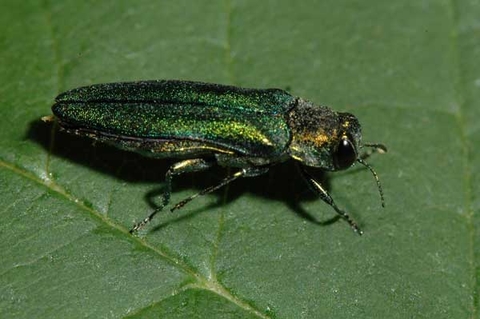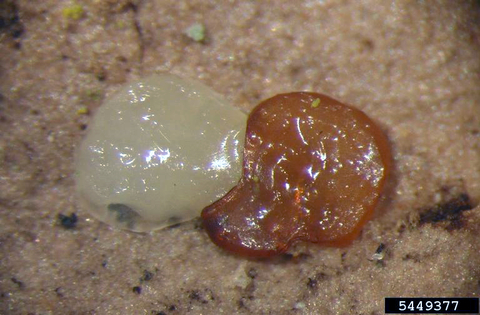Quick facts
Emerald ash borer is a quarantined invasive species. Items that could transport this insect may not be moved without permission from the Minnesota Department of Agriculture.
- The emerald ash borer (EAB) is a very destructive insect pest of ash trees.
- EAB attacks all species of North American ash.
- Once an ash is attacked by EAB, it will be killed if it is not protected.
- Ash trees can be protected from EAB with available insecticides.
- EAB will move only about one-half to one mile a year from infested sites. But people can carry it hundreds of miles when transporting firewood and other wood products or nursery stock.
The Minnesota Department of Agriculture monitors this invasive species. Please report any EAB you spot at Report a Pest.
Emerald ash borer (Agrilus planipennis) is a metallic wood-boring beetle (family Buprestidae). It is a little larger and much more brightly colored than bronze birch borers and two-lined chestnut borers.
See other insects that may be confused with emerald ash borer.
Emerald ash borers generally have a one-year life cycle that can extend to two years in a vigorously growing tree. Learn about the signs and symptoms of EAB infestation in ash trees.
Adult stage
- The adult beetle has a bright iridescent emerald to coppery green-colored body. It has a purplish magenta abdomen under its wings and may have a copper-colored area behind the head.
- The slender body is 1/3 to 1/2-inch long, widest just behind the head and gradually tapering back to the abdomen.
- Adults emerge from infested ash trees from late May to August, creating small, 1/8-inch D-shaped exit holes.
- After feeding on ash leaves, adults mate and females lay 40-200 eggs in small cracks in the bark.
Egg stage
- Eggs are small (1 mm), difficult to find and rarely seen.
- Eggs hatch in about 7 to 10 days and larvae immediately bore into the tree.
Larval stage
- Larvae are 1 to 1-1/4 inches when fully grown.
- They have a flat, milky white body with a small brownish head.
- They have no legs but have a pair of small pincer-like appendages on the tip of the abdomen.
- After hatching, larvae tunnel just under the bark of ash trees and feed until fall.
- They create winding, S-shaped galleries in the outer sapwood and in the tissue (phloem) that carries food from the leaves to the rest of the tree. These tunnels girdle the trunk and branches, interrupting the flow of water and nutrients in the tree.
- Younger larvae live through the winter in their galleries. They will resume feeding in the spring.
- Once larvae are fully grown, they wait another winter until they pupate in early spring (2-year life cycle).
Pupal stage
- Pupas are initially cream-colored and darken over time.
- They develop to look more like an adult beetle.
- Adult beetles emerge from the tree in late spring, completing the life cycle.
Temperature impacts on EAB
Severe cold harms EAB and slows its spread and development.
Emerald ash borer larvae overwinter beneath the bark of ash trees. Research has shown that if the temperature reaches -20 degrees F, about 50% of EAB larvae will die. If the temperature reaches -30 degrees F, about 90% of EAB larvae will die.
In the forest, different factors influence whether or not EAB larvae can survive. The location of the tree (for example, whether it's found on a north- or south-facing slope), the diameter of the tree, and the snow depth can all influence whether or not EAB will survive at cold temperatures.
EAB is less vigorous in northern climates compared to more southerly ones. In northern latitudes, EAB larvae are smaller, take longer to develop into insects, and produce fewer eggs.
While cold weather can slow the spread of EAB, the climate alone may not eliminate EAB from Minnesota’s landscape. However, cold temperatures in northern parts of the state have helped limit the spread of EAB into its expansive ash forests.
EAB biocontrol
The Minnesota Department of Agriculture (MDA) has released four species of wasps to help manage EAB. These wasps do not sting humans and may only be released by MDA. The U.S. Department of Agriculture’s Animal and Plant Health Inspection Service (APHIS) working with the U.S. Forest Service did extensive testing on these wasps to ensure they do not negatively impact the environment or other species. It is still unclear if they can slow the spread of EAB. For more information visit the MDA’s Biocontrol webpage.
Reviewed in 2024





